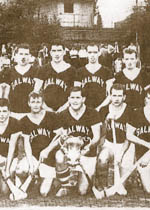Old Galway
130 Years Of Connacht Rugby (22 01 2015)

The Connacht Branch of the Irish Rugby Football Union was formed on December 8th, 1885 in Corless’ Burlington Dining Rooms, Andrew Street & Church lane Dublin. The meeting took place after the first time Connacht ever played as a province in a match against Leinster. The clubs represented at the meeting were Ballinasloe, Castlebar, Galway Grammar School, Galway Town, Queen’s College Galway and Ranelagh School, Athlone.
The Patrician Brothers In Galway (15 01 2015)

On this day, the 15th of January in the year 1827, the Patrician Brothers arrived in Galway for the first time. Brothers Paul O’Connor and James Walsh took up residence in the Charity Free School in Lombard Street. 300 boys attended that day. This school for the poor was originally founded in 1790 in Back Street (now Augustine Street). In 1824, it transferred to the Lombard Street barracks which had been built in 1749, and purchased from the Government by Warden French in 1823. It had been a struggle to keep the school going so the Patricians were invited to take it over and manage it. The barracks formed three sides of a square, the Brothers lived in one wing and the school occupied
Calling all 'Pres' Past Pupils (08 01 2015)

Two hundred years ago (on the 27th of October 1815) the first Presentation Sisters came to Galway and founded the first Catholic Schools for girls in the city. They moved in to Kirwanís lane, then to Eyre Square for 3 years before settling into a vacant house in the suburbs, which has been known as the Presentation Convent ever since.
Representing Glenard ( 29 12 2014)

The name Gleann Árd long pre-dated the creation of the housing estate which was built in Salthill by the Brennan Brothers in the 1960’s and which they named Glenard. The Persse family were hugely influential in County Galway in the 19th century and produced many distinguished members in the fields of the Arts, Politics and business. One of these was Henry Sadleir Persse who had the distillery in Nun’s Island. He built a house up on the hill overlooking Salthill and called it Glenarde House; today, it is known as the Ardilaun Hotel.
Memories Of Sonny Molloy (25 12 2014)

Sonny (whose real name was Joseph) was born 89 years ago, one of six children to Patrick and Mary Molloy of St. Brendan’s Road in Woodquay. He went to the ‘Mon’ where he learned to play football amongst other things. A match report in a local paper once carried the headline “Five Goal Molloy”, a fact which he managed to drop into conversation many times over the years. Chatting with him could be unnerving as he laced his chat with colourful sayings like “Long Drawers”, ‘Bring up the Bucket’, “Th’oul suit turned well”, ’44 Short’, “I hate small men” and of course his famous draper’s mantra “We Have Your Size”.
High Street Facades (18 12 2014)

Galway Grammar School was founded by Erasmus Smith about 1667 in a temporary premises and it moved to High Street about 1684. An entry in the records for January 22nd 1684 reads “That Dr. John Coghill be desired to write unto Mr. Patrick Mains in Gallaway that he will more particularly inspect the house there belonging unto Sir Robert Ward concerning the necessary repairs to make it convenient for a school and a commodious dwelling for the schoolmaster and usher and for boarders lodgings that it will amount to”.
A Postcard Of Toft’s Amusements (11 12 2014)

The Toft family were associated with Eyre Square for many years since 1883 when they first brought a carnival there. Abby Toft, a Dub, ran the amusements through the early years. He married Florence Piper from Tramore and they had three children, Claude, Kenneth and Maureen. Kenneth joined the RAF during World War II and his plane was shot down over Germany. He parachuted to safety but was captured and spent the rest of the war in a POW camp. He came home after the war and by way of celebration, his mother built the amusement arcade in Salthill for him.
Galway Three-In-A Row Teams (04 12 2014)

The Galway Senior football team played in four All-Ireland finals in a row from 1963 to 1966. They lost the first one to Dublin but achieved a magnificent three in a row in 1964, 1965 and 1966. They were not the only Galway team to do so as the New York Galway Senior Hurling Team managed a similar treble, winning the New York Championship in 1964, ‘65 and ’66.
.png)